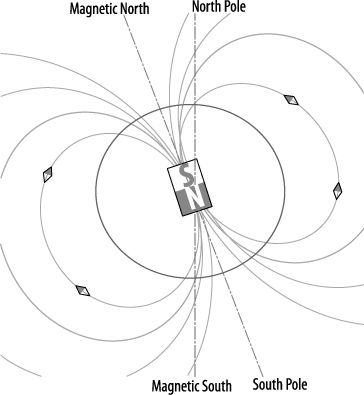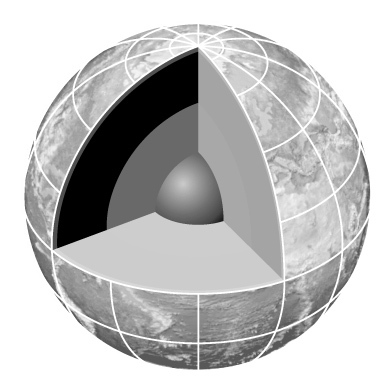128
Magnetic North Pole
![]()
Somewhere in Canada
Not only is the Magnetic North Pole difficult to get to, but it also moves over 10 kilometers per year, and it even moves in a rough oval as much as 80 kilometers each day. But it is roughly the spot to which compasses point when determining the direction “north.” Until GPS completely displaces compasses, for the purposes of navigation it’s important to know the location of the Magnetic North Pole and the lines of the Earth’s magnetic field (Figure 128-1).

Figure 128-1. The North Pole and Magnetic North Pole
The Earth rotates on its axis, at 23.5º to the perpendicular to the Earth’s orbit around the Sun. The axis passes through the Geographic North and South Poles. The location of the geographic poles sets the lines of longitude; latitude is measured from the Equator, which sits halfway between the poles. The axis and the poles are the basic reference points for navigation.
Unfortunately, compasses do not point to the Geographic North Pole, but instead follow the Earth’s magnetic field and point approximately toward the ever-moving Magnetic North Pole. To compensate for this problem when using a compass, it is necessary to know the declination. At any point on the Earth, the declination is the angle between a line drawn to the Geographic North Pole and the direction in which the compass is indicating north.
The Earth’s magnetic field can be approximated by imagining that the Earth contains a large bar magnet whose south pole points toward the Magnetic North Pole and whose north pole points toward the Magnetic South Pole. (In reality, the Magnetic North and South Poles are not diametrically opposite each other, and the Earth’s magnetic field is not even uniform across the Earth’s surface.)
The imaginary bar magnet is titled approximately 11º degrees from the Earth’s rotational axis. The south pole of this imaginary magnet points to a spot called the Geomagnetic North Pole, which is located near Greenland at 79.74° N, 71.78° W. But only about 90% of the Earth’s magnetic field can be approximated by a bar magnet—the other 10% causes the Earth’s magnetic field to vary by location and so the Magnetic North Pole and the imaginary Geomagnetic North Pole do not coincide.
Currently, the Magnetic North Pole is located in the far north of Canada. In 2001, it was found to be at 81.3°N, 110.8°W. When navigating north with a compass, a traveler will follow the lines of the Earth’s magnetic field, eventually arriving at the Magnetic North Pole, but not by the most direct route because of variations in the field. For this reason, the compass only approximately points to the Magnetic North Pole, and declination varies from place to place.
It is possible to reach both the Magnetic North Pole and the Geographic North Pole by starting in the far north of Canada at Resolute Bay in Nunavut. The Qausuittuq Inn at Resolute Bay has been the starting point for many such expeditions (ask there for directions!).
The truly hardy can enter the biannual Polar Race from Resolute Bay to the Magnetic North Pole.
Practical Information
The Qausuittuq Inn’s website is http://www.resolutebay.com/. The Polar Race can be found at http://polarrace.com/.
